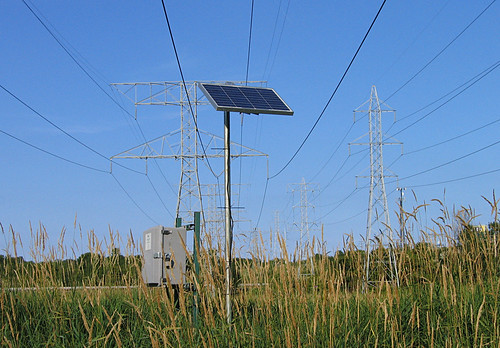Trade-in the 20th Century Electric Grid, Don’t Trade-off Local Energy
In a New York Times SundayReview piece last month – Drawing the Line at Power Lines – Elisabeth Rosenthal suggested that our desire for clean energy will require significant tradeoffs:
There are pipelines, trains, trucks and high-voltage transmission lines. None of them are pretty, and all have environmental drawbacks. But if you want to drive your cars, heat your homes and watch TV, you will have to choose among these unpalatable options…
Perhaps the answer is simply that in an increasingly crowded powered-on world, we’re all going to have to accept that Governor Cuomo’s so-called energy highway is likely to traverse our backyard.
I disagree.
The future of American electricity policy is not about tradeoffs, but rather a chance to trade-in an obsolete, centralized paradigm for a local, clean energy future. Utilities would have us believe that new high-voltage transmission lines are necessary to get more wind and solar power. But the truth is that the American electricity industry refuses to embrace the fundamentally different nature of renewable energy: its ubiquity means that Americans can produce energy near where they use it, in an economically competitive manner, and at a community scale.
The 20th century electricity system was centrally controlled and centrally-owned, a necessary evil when coal, gas, and nuclear power plants had significant economies of scale and required enormous capital investments. The supply lines for these power plants were equally large, connecting far-off mines, oil and gas fields via rail and pipeline to these remote power plants, and big transmission lines in turn carried the electricity from these power plants to big urban centers.
An electricity system primarily powered by wind and solar is fundamentally different. Turbines and panels are always right at the fuel source, whether on a rural farm or an urban rooftop. And because their scale is substantially more amenable to community ownership, renewable energy can be built near to and provide economic benefits to the communities it powers.
The fundamental shift means Americans should trade-in an obsolete model of centralized energy generation for one that matches and builds support for the local energy opportunity.
Local ownership and its economic benefits should play a significant role. For example, researchers in Germany recently surveyed local support for expanding wind energy production, comparing two towns with nearby wind farms. When the local turbines were absentee-owned, 60 percent of residents were opposed to more local wind power. Opposition dropped by 45 percentage points when the wind farm was locally owned. It’s no different from the fight over the Badger-Coulee transmission line in Western Wisconsin, where locals have raised hell knowing that they will be asked to pay as much as $5 billion for new transmission lines that will earn utilities an 11% (or greater) return with questionable local economic benefit.
Locally owned wind power is in short supply, however, because federal and state energy policy make it extremely difficult. Community ownership could be best achieved through cooperatives, schools, or cities, but federal wind incentives are for taxable entities, not these rooted community organizations. Furthermore, federal tax credits require wind power project participants to have “passive income” from investments, ruling out the vast majority of Americans. When community wind projects succeed, like the South Dakota Wind Partners, organizers admit that repeating the success is unlikely in light of the legal and financial complexities.
Community-scaled wind and solar projects also struggle against an electricity system stacked against small-scale or “distributed” generation. A recent study in Minnesota, for example, suggested that the state could meet its entire 25% by 2025 renewable energy standard with distributed renewable energy projects connected to existing electric grid infrastructure. Incumbent utilities have focused on transmission instead, likely because new power lines (and not maximizing existing infrastructure) earns them a statutory 11-13% rate of return.
This myopic focus on big infrastructure may prove doubly expensive as the cost of solar power falls rapidly. Within 10 years, one-third of Americans could install solar on their own rooftop and get electricity for less than their utility charges, without any additional power lines. But under the current electricity policy, these same Americans will likely be paying a few dollars each month for new utility-conceived high-voltage transmission lines even as they increasingly produce their own local, clean energy.
The future of American energy policy is not a tradeoff between new clean energy and new transmission. Rather, it’s an opportunity to trade-in an obsolete, centralized model of development for the alternative — a democratized energy system where Americans can be producers and owners of their energy future.
This post originally appeared on Energy Self-Reliant States, a resource of the Institute for Local Self-Reliance.
Have a tip for CleanTechnica? Want to advertise? Want to suggest a guest for our CleanTech Talk podcast? Contact us here.
Latest CleanTechnica.TV Video

CleanTechnica uses affiliate links. See our policy here.

